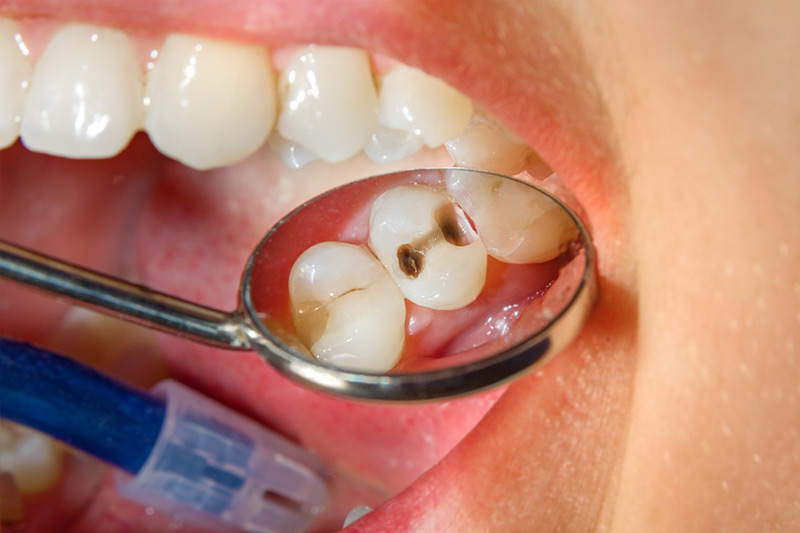
The signs of a cavity depend on the severity of the problem and where it is located in your mouth. Often, you might not even know you have a cavity until the area of decay becomes more prominent and you develop symptoms.
Fortunately, there are ways to detect a cavity early on and things you can do to prevent a cavity from forming. So, what do cavities look like?
What Does the Start of a Cavity Look Like?
Visibly seeing a cavity, especially in the early stages, can be difficult. By understanding the stages of cavities, you can better detect one.
Stages of Tooth Decay
These are the five stages of tooth decay. Understanding the process of a cavity can help you detect it sooner, take measures to prevent cavities, and practice good oral hygiene.
Demineralization
Demineralization is when your tooth begins to accumulate plaque and lose calcium. This starts when the plaque’s bacteria feed on the sugar you consume, releasing an acid as the sugar metabolizes it.
The acid is released onto your tooth’s enamel, causing your tooth to have white spots in the affected area due to the loss of essential minerals. To treat demineralization, you will need a fluoride treatment or minerals such as hydroxyapatite to replenish the ones your tooth has lost.
Enamel Decay
This stage is when your tooth’s enamel begins to decay. During this process, the white spots on your teeth turn brownish. If left untreated, these brownish spots on your tooth will become a cavity. To treat enamel decay, you will need a filling.
Dentin Decay
If your enamel decay is untreated, your tooth will progress to the dentin decay stage. In this stage, the decay spreads to the next layer of your tooth, the dentin. Since this layer is softer than enamel, the acid damage is quicker.
You will likely notice symptoms when you experience dentin decay, such as extreme tooth sensitivity to cold, hot, and sugary foods. You must visit your dentist if you begin to feel this extreme sensitivity. To treat dentin decay, you will either need a filling or a crown replacement, depending on the severity of the decay.
Pulp Decay
During the pulp decay stage, the decay will have already taken over the center of your tooth, leaving a hole in your tooth. In this stage, you will feel notable pain near your affected tooth.
When the decay reaches the center of your tooth, it targets the nerve endings and blood vessels that are inside, causing more pain. To treat pulp decay, you will need a root canal.
Abscess
An abscess is the last stage of tooth decay. In this stage, the bacteria takes over your tooth’s root and causes an infection.
You will know if you have an infection when pus forms at the bottom of your affected tooth. If an abscess is left untreated, it will cause damage to your jawbone and the surrounding tissues. To treat an abscess, you will need a root canal. For severe cases, a dental extraction may be necessary.
What Does a Cavity Look Like On a Molar?
On a molar, a cavity will typically look like it has a white or chalky appearance on your tooth’s enamel in the early stages.
If you have had the cavity for a while and it was not treated, it will eventually turn brown or black in appearance, there will be a hole in the center of your tooth, or you will experience pus coming out of the bottom.
What Does a Cavity Look Like On an X Ray?
On an X Ray, cavities look like dark areas on your tooth. Cavities begin on the outside layer of your tooth, or the enamel, which has a light gray color in the X ray. As the cavity progresses to the dentin, it appears to have a darker color than the enamel.
How to Tell If a Spot Is a Cavity
Sometimes, spots on your teeth can be stains, appearing to be white, brown or black. Stains are often mistaken for cavities because they share similar colors. Typically, a white spot tends to signal that a cavity is forming.
If your teeth are stained, they are usually brown due to consuming coffee, soda, or tea.
How to Prevent Cavities
The best way to prevent cavities is to practice good oral hygiene and eat a healthy diet. Some tips to help prevent cavities include:
- Visit your dentist regularly
- Brush your teeth twice daily
- Use a toothe paste with nano-hydroxyapatite and/or fluoride
- Floss once daily
- Eat foods rich in vitamins
- Cut back on sugary or acidic foods
What Does a Cavity Look Like: FAQs
What does a small cavity look like?
A small cavity has a chalky, white appearance on your tooth. As it worsens, it can appear darker.
What does the beginning of a cavity look like?
The beginning of a cavity starts as white spots on your teeth, eventually turning to a brown or black spot if left untreated. Once the cavity progresses, you might experience tooth sensitivity or pain.
What does a hidden cavity look like?
A hidden cavity is a hole between your teeth or the crevices you can’t visibly see or touch. However, you might still feel pain or tooth sensitivity. If you believe you have a hidden cavity, your dentist can confirm with an X ray the progression of your cavity.
Conclusion
You may be at risk for cavities if you snack between meals, consume sugary meals or drinks, have cracked or chipped teeth, or have a personal or family history of cavities. Cavities can be prevented by regularly visiting your dentist and practicing good oral hygiene.
Check out Dr Kami’s Book: If Your Mouth Could Talk to order your copy today!

